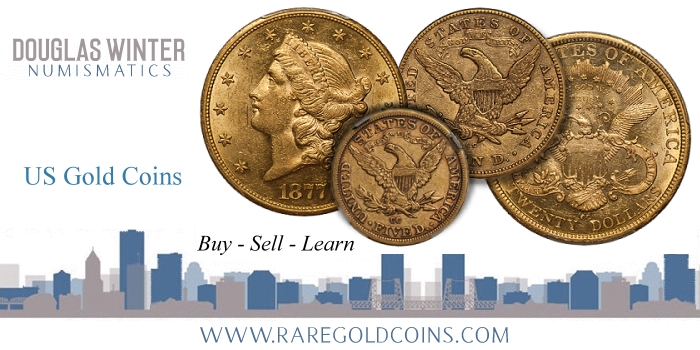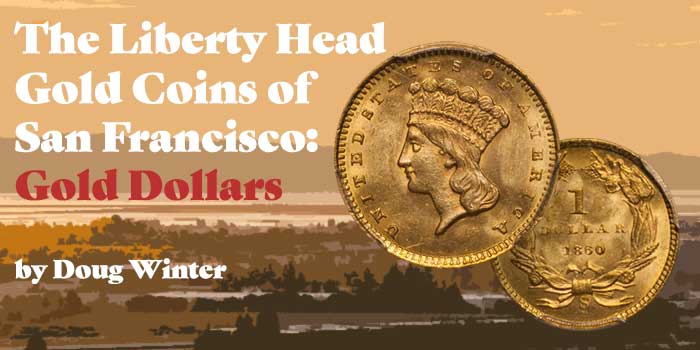
By Doug Winter – RareGoldCoins.com ……
CoinWeek Content Partner ……
Only seven gold dollars were made at the San Francisco Mint, but no less than three design types are represented; this includes two one-year types. The three types are as follows:
- Type One: 1854 only
- Type Two: 1856 only
- Type Three: 1857 through 1860 and 1870
This is a popular set with collectors given the fact that it is short and completable. Lower budget sets can be assembled with the coins in the EF-AU, range while collectors with larger budgets can focus on Uncirculated sets with the coins grading MS62 to MS65.
* * *
1854-S
- Total Minted: 14,632
- Estimated Survivors: 250-350+
- Rarity Ranking: 6th of 7
The 1854-S gold dollar is doubly popular as the first gold dollar made at the newly opened San Francisco Mint and as a one-year type.
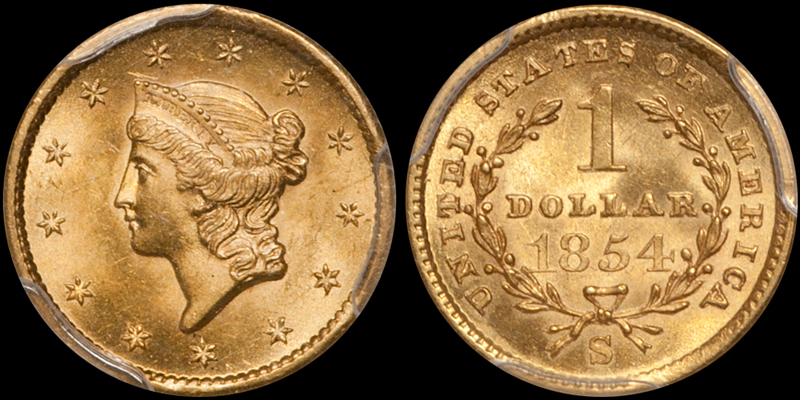
1854-S $1.00 PCGS MS64 CAC. Images courtesy Douglas Winter Numismatics (DWN)
This is a very well-made issue that typically is seen with an excellent strike, good luster, and choice planchets. The natural color is a rich orange-gold with rose undertones while the luster is very frosty.
It is likely that 1854-S gold dollars were saved as souvenirs and this date is more plentiful in Uncirculated than one might expect. There are at least four to five dozen in Uncirculated with most of these in the MS60 to MS63 range. I believe that there are around six or seven properly graded MS64s, and I am aware of just one Gem, a PCGS/CAC MS65+ that was last sold as part of the Duckor Collection in the 2015 Heritage ANA auction at a record-setting $56,400 USD.
Lower budget sets should focus on a nice AU, which should be available for less than $2,000. Higher budget sets might focus on an MS64, which should cost in the $12,500-15,000 range; these are rare but are generally offered for sale around once every year or so.
1856-S
- Total Minted: 24,600
- Estimated Survivors: 300-400+
- Rarity Ranking: 7th of 7
The 1856-S gold dollar is another numismatically significant gold dollar from San Francisco as it is the only Type Two issue from this facility.
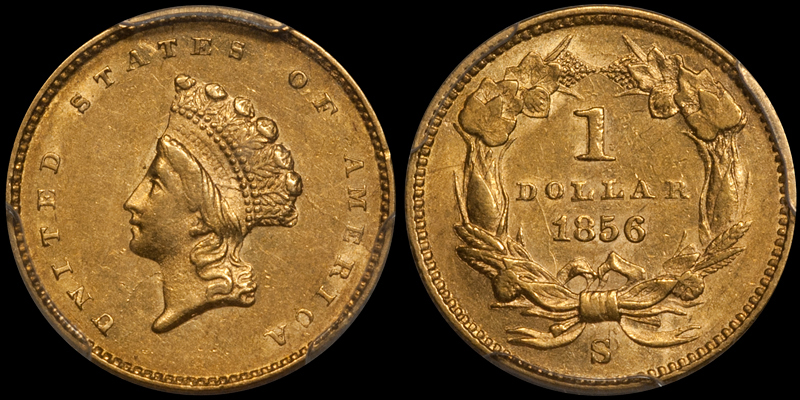
1856-S $1.00 PCGS AU55+ CAC
This issue is not quite as well-struck as the 1854-S, but it is better produced than the Southern Type Two gold dollars (especially the 1855-C and the 1855-D) that are typically characterized by very negative eye appeal. The natural color is a deep green-gold but higher-grade pieces are more likely to show rich rose-gold and orange hues. The luster is slightly grainy in texture.
There were at least 18 Uncirculated 1856-S gold dollars found in the second salvage of the SS Central America, including a small number of Gems. Prior to this, the finest known was a PCGS/CAC MS64 from the Duckor Collection, which sold for $44,650.
Collectors should not pay a premium for the 1856-S/S variety that is actually more common than the normal mintmark. It has a low population but this is due to its new acceptance by PCGS as a variety.
Lower-budget sets should focus on a nice AU which is available for $3,000 or so. Higher-budget sets might focus on an MS62, which will cost around $15,000-17,500. High-grade SSCA 1856-S gold dollars have trickled into the market and a PCGS/CAC MS64+ just brought a strong $88,125 as Legend 5/19: 482.
1857-S
- Total Minted: 10,000
- Estimated Survivors: 150-175
- Rarity Ranking: 2nd of 7
The 1857-S introduces the five Type Three gold dollars from San Francisco. It is the second rarest in overall rarity (after the 1870-S) but it is the rarest in Uncirculated. This is a legitimately rare issue in high grades with fewer than 10 known in Mint State, and nearly all in the lower range of this grade. The finest graded is a single PCGS MS64 and the best I have ever seen is the Bass 2: 121 coin, graded MS63, that brought $16,100 in October 1999.
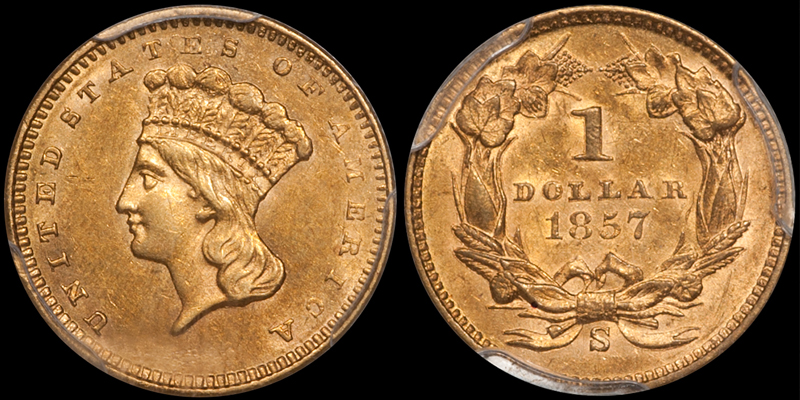
1857-S $1.00 PCGS AU58 CAC
The strike is reasonably sharp although many pieces show some weakness on the 85 in the date while others are weak on the ICA in AMERICA. Very few exist with original color and such coins command significant premiums.
This date is much undervalued in nice AU grades with examples available for less than $2,000. Higher-grade sets will find the 1857-S to be challenging, and I haven’t seen a nice PCGS-graded Uncirculated piece in a number of years.
1858-S
- Total Minted: 10,000
- Estimated Survivors: 175-200
- Rarity Ranking: 3rd of 7
The 1858-S gold dollar has the exact same mintage figure as the 1857-S but it is slightly more available in terms of overall rarity. It is also a very rare issue in Uncirculated with fewer than 10 currently known. There is a single Gem known (graded MS65 by PCGS/CAC) which is in the Simpson Collection and the Duckor coin, graded MS64 by PCGS/CAC is the second finest.

1858-S $1.00 PCGS AU58 CAC
The 1858-S dollar typically has some weakness in the hair but the overall strike is above average. Higher-grade pieces are very frosty with rich yellow-gold and orange color. This date is not often seen with original color and choice surfaces but it is slightly easier to locate choice than the 1857-S.
As with the 1857-S, the 1858-S gold dollar is highly undervalued in nice AU grades and a very presentable example can still be located for $2,000 or less. Higher-grade examples are offered at a rate of maybe one or two per year, and a PCGS MS61 will cost around $5,000. An MS62 will run around $8,000-9,000.
1859-S
- Total Minted: 10,000
- Estimated Survivors: 200-250
- Rarity Ranking: 4th of 7
This is the third consecutive San Francisco gold dollar with a mintage of 10,000. The 1859-S is slightly more available than the 1857-S and the 1858-S but it is also rare in Uncirculated. Fewer than a dozen Mint State pieces are currently known, with most in the MS60 to MS62 range. I have personally handled just one in MS63, and the finest I am aware of is a PCGS MS64, which brought $17,000 in the March 2005 ANR sale.

1859-S $1.00 NGC AU55 CAC
The strike tends to be a little weaker than on the previous two issues and there is sometimes blurriness on the OLL in DOLLAR. The tops of some of the letters in AMERICA may show weakness as well. The natural color is a rich orange-gold hue and only a small number of 1859-S dollars have not been scrubbed or altered. The luster is frosty with a slightly different texture than that seen on the 1857-S or the 1858-S.
A nice AU can still be located for under $2,000, which I feel is excellent value given the scarcity of this issue. The best available quality caps out at around MS62 and, if available, such a coin should cost around $7,500.
1860-S
- Total Minted: 13,000
- Estimated Survivors: 225-275
- Rarity Ranking: 5th of 7
The 1860-S is slightly more available than the 1857-S, 1858-S, and 1859-S gold dollars. In Uncirculated it is very scarce but as many as 15-20 exist, making it more available than the previous three issues. It is also more available in MS63 and MS64 than these three issues, which are essentially non-existent. The finest known is a single PCGS/CAC MS65, which I sold privately to Steve Duckor in late 2013, and which later sold for $31,725 as Heritage 2015 ANA: 4260
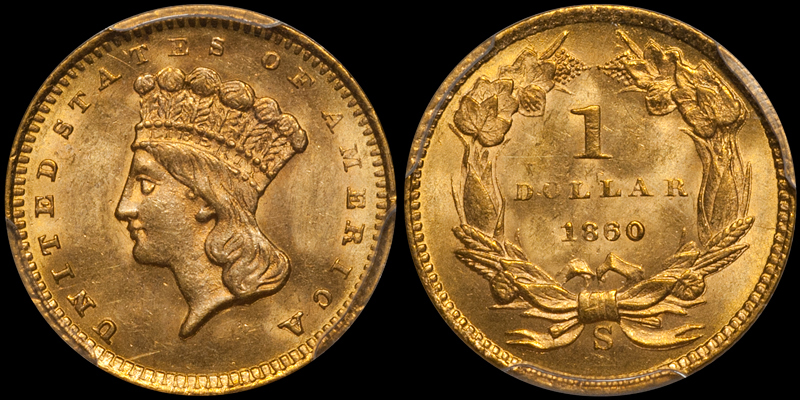
1860-S $1.00 PCGS MS64
This issue tends to be well-struck although some show weakness on the top of the 8 in the date and the O in DOLLAR. The luster is very frosty and is more similar to that seen on the 1859-S than on the 1857-S and the 1858-S. Original high-grade pieces (of which not many are known) show rich orange-gold, rose, and green-gold hues.
Nice AU 1860-S gold dollars are extremely affordable with examples still trading for less than $1,500. An MS62 can be obtained for less than $4,000 and even an MS63 still sells for around $5,000. I regard these as all being exceptional values, even when compared to the other Type Three San Francisco gold dollars.
1870-S
- Total Minted: 3,000
- Estimated Survivors: 125-150
- Rarity Ranking: 1st of 7
The grade distribution of this date is entirely different than for the other Type Three San Francisco gold dollars. The 1870-S saw little circulation and very few examples exist below AU55. The grade range seen most often is MS61 to MS63 with MS64 examples being rare, and Gems being extremely rare. PCGS has graded a single coin MS66; it didn’t sell in a 2002 auction and it hasn’t been seen since.
Two Gems have sold in recent years: the Duckor coin–graded MS65 by PCGS/CAC–which brought $37,600 in 2015, and the Simpson coin–graded MS65+ by PCGS/CAC–which brought $42,300 later in 2015.
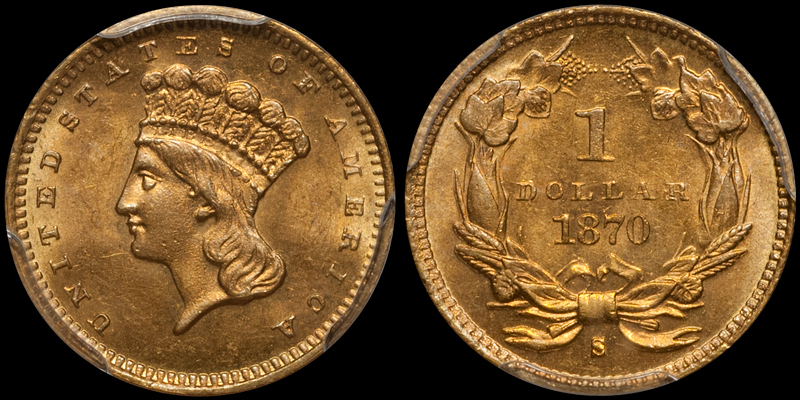
1870-S $1.00 PCGS MS63 CAC
The 1870-S is a well-struck issue that is fully defined at the centers and the borders. The color tends to be reddish-gold or orange-gold, but many coins are bright and lack character from having been dipped. The luster is somewhat reflective with a much different texture than those seen on the other Type Three issues from this mint. Many 1870-S gold dollars show die striations on the reverse that are mint-made.
Affordable examples are actually hard to locate due to the fact that this date is the rarest San Francisco gold dollar and, as I mentioned, it is almost never seen below AU55. A nice slider should cost around $3,000, while a higher-grade collection would likely focus on an MS63 at around $7,000 or an MS64 at around $12,000.
The short-lived San Francisco gold dollar set is very completable and it is interesting due to its inclusion of three distinct types. It makes for a good introduction to San Francisco gold coinage.
Part Two in this feature on San Francisco gold coinage will cover the interesting quarter eagles, made from 1854 through 1879.
* * *
About Doug Winter
 Doug has spent much of his life in the field of numismatics; beginning collecting coins at the age of seven, and by the time he was 10 years old, buying and selling coins at conventions in the New York City area.
Doug has spent much of his life in the field of numismatics; beginning collecting coins at the age of seven, and by the time he was 10 years old, buying and selling coins at conventions in the New York City area.
In 1989, he founded Douglas Winter Numismatics, and his firm specializes in buying and selling choice and rare US Gold coins, especially US gold coins and all branch mint material.
Recognized as one of the leading specialized numismatic firms, Doug is an award-winning author of over a dozen numismatic books and the recognized expert on US Gold. His knowledge and an exceptional eye for properly graded and original coins has made him one of the most respected figures in the numismatic community and a sought after dealer by collectors and investors looking for professional personalized service, a select inventory of impeccable quality and fair and honest pricing. Doug is also a major buyer of all US coins and is always looking to purchase collections both large and small. He can be reached at (214) 675-9897.
Doug has been a contributor to the Guidebook of United States Coins (also known as the “Redbook”) since 1983, Walter Breen’s Encyclopedia of United States and Colonial Coins, Q. David Bowers’ Encyclopedia of United States Silver Dollars and Andrew Pollock’s United States Pattern and Related Issues
In addition, he has authored 13 books on US Gold coins including:
- Gold Coins of the New Orleans Mint: 1839-1909
- Gold Coins of the Carson City Mint: 1870 – 1893
- Gold Coins of the Charlotte Mint: 1838-1861
- Gold Coins of the Dahlonega Mint 1838-1861
- The United States $3 Gold Pieces 1854-1889
- Carson City Gold Coinage 1870-1893: A Rarity and Condition Census Update
- An Insider’s Guide to Collecting Type One Double Eagles
- The Connoisseur’s Guide to United States Gold Coins
- A Collector’s Guide To Indian Head Quarter Eagles
- The Acadiana Collection of New Orleans Coinage
- Type Three Double Eagles, 1877-1907: A Numismatic History and Analysis
- Gold Coins of the Dahlonega Mint, 1838-1861: A Numismatic History and Analysis
- Type Two Double Eagles, 1866-1876: A Numismatic History and Analysis
Finally, Doug is a member of virtually every major numismatic organization, professional trade group and major coin association in the US.


